
|   |

|   |
 e-mail: sunilkothari1933@gmail.com Bangladesh Shilpakala Academy’s two day Manipuri Dance Festival Pics courtesy: Bangladesh Shilpakala Academy and Shadhona Institute July 4, 2018 Bangladesh Shilpakala Academy arranged a two day Manipuri dance festival in collaboration with Guru Bipin Singh Centenary Festival to pay tribute to the legendary Manipuri guru in Bangladesh. It was Guru Bipin Singh’s disciple Shantibala Devi who had thirty years ago during her visit to Dhaka started teaching Manipuri dances to local young girls. Among them was Tamanna Rahman who took to studying it seriously. The seeds of Manipuri dance were thus planted in Bangladesh. 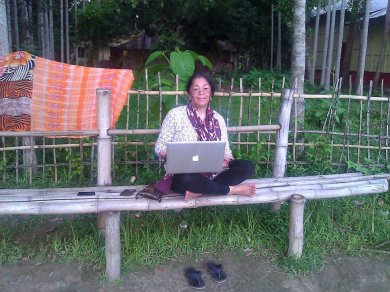 Lubna Marium’s favorite place in Ghoramara 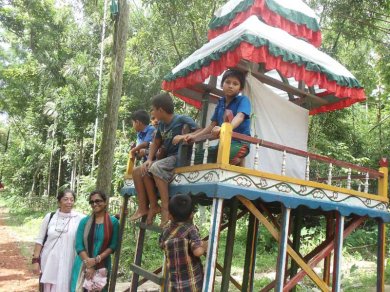 Preparing for Rath Yatra 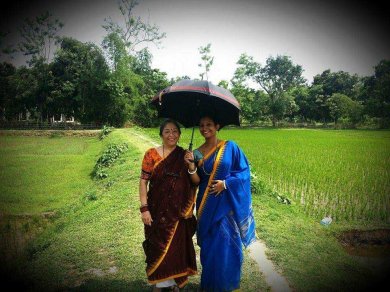 Lubna Marium and Sweety Das 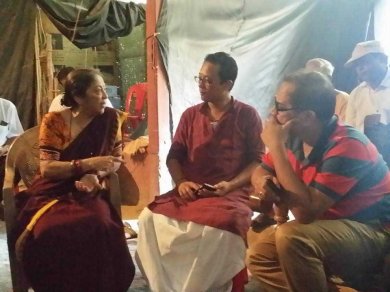 Discussing the Dhrumel Project with Sandeep Chakravorty, Deputy High Commissioner, Indian HC When Leela Venkataraman and I received an invitation to visit Dhaka to attend the two day Manipuri dance festival, we had not expected to learn so much about how Manipuri dances had taken roots in Bangladesh. We were also intrigued that majority of population is Muslim, and how classical Indian dances were being practiced in Bangladesh. Also we did not know till we saw and met the Vishnupriya sect Vaishnav Manipuri artists from a village known as Ghoramara, at a distance of some five hours journey from Dhaka, who have settled there since past 200 years! And they continue performing and observing Hindu rituals till today. Lubna Marium, Director of Shadhona, a premiere institute of dances in Bangladesh and a celebrated dancer, choreographer, scholar, researcher, and a visionary who had extended us hospitality for another two days for attending Bharatanatyam performances of her troupe of Kolpotoru, explained to us that if we see these Indian classical dances being performed and practiced in Bangladesh, it has been on account of people’s will. When Jinnah in East Pakistan wanted only Urdu to be the national language, there was a national language movement to maintain Bengali as a national language and not Urdu. The entire nation agreed and Bengali remained the national language. The Mukti Sangram in 1971 when Bangladesh as a nation came into existence, succeeded in supporting language movement. Thus Bengali as a language has been all inclusive of culture. Before India and Pakistan became two countries during the British Rule, India was one nation. Bengal was an important state where Bengali language prevailed. The catholicity of people did not admit of division of religion, caste, and creed. The Muslim musicians like Dagar family prayed and sang praises of goddess Saraswati. The Muslim musicians sang devotional songs. Gurudev Rabindranath Tagore’s Rabindra Sangeet with exquisite Bengali poetry was a part of one’s growing up. The great poet Kazi Nazrul Islam’s Shyama Sangeet is another example of confluence of Muslim and Hindu culture. As a matter of fact, the Bengali language carries identity of Hindus and Muslims as one community. Therefore we were told that in Bangladesh we will not find that division. Yes, in Pakistan, dance is a taboo, but not in Bangladesh. And no one feels offended when arati is offered, or before the program begins, lamp is lit with a prayer in Sanskrit. In Bengal, Manipuri dances became very popular. Manipur tucked in North East corner of India with an treasure trove of their indigenous ritual dances of Maibi and Maiba, Lai Haraoba, during the reign of Maharaja Bhagyachandra adopted Vaishnava religion. That brought two regions of Manipur and Bengal together. The visits of saints of Bengal to Manipur brought Bengali Vaishnava songs to Manipur. Gita Govinda became a part of Manipuri dance with its rich Sanskrit poetry. Bengali padabali became part of singing and dancing in Manipur. These two regions enriched themselves with dance and music traditions. Manipuri dances are most popular in Bengal. Tagore, when he saw Manipuri dances for the first time, invited a Manipuri guru to teach at Shantiniketan. Gurudev also used Manipuri dances in his dance-drama productions like Chitrangada. Manipuri was taught regularly in Shantiniketan and it continues even today. Thus Bengali language and people have embraced Manipuri dances affectionately. Therefore, to honour Guru Bipin Singh during the centenary year was a natural outcome of celebrations by Bangladeshi Manipuri exponents. We were told that Kalavati Devi went there for three weeks and conducted workshops and also helped the local Bangladeshi and Ghoramara village artists to mount various dance compositions of Guru Bipin Singh. A brilliant young pung player Brojen Singh, a disciple of Kalavati Devi from Cachar, has been regularly visiting Dhaka to train Ghoramar artists and has trained a number of artists in pung playing. From Shadhona’s Kolpotoru section also male dancers from Dhaka have studied pung. Two young male students along with their academic studies are also learning pung. Since we were informed about the traffic jam in Dhaka right from the airport when we landed at 4.30pm we were led straight to National Theatre where the festival was held. After more than one hour long drive, we reached just in time and were taken backstage where we saw a large number of dancers getting ready for the performances with several Manipuri costumes. It was a huge space where dancers can get ready and enter the stage in a large number. With lighting of the lamp to stuti of light in Sanskrit, the performances began. The very first impression was spectacular. In Manipuri costumes, the dancers formed one inner circle and one outer circle. They moved in opposite direction forming interesting circular pattern. The use of pena, typical one stringed instrument, created hypnotic effect. The pining of Radha to unite with Krishna was suggestive. 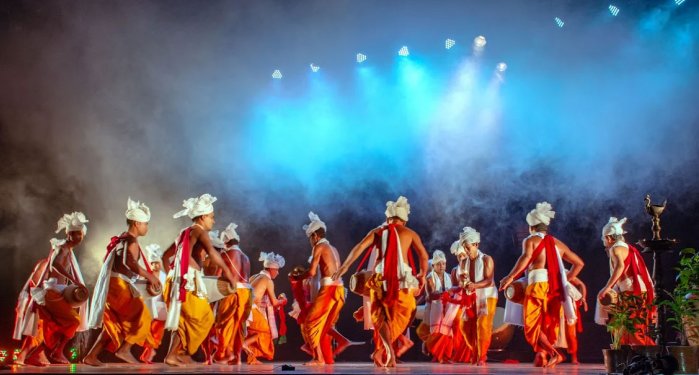 Meihourol Photo: Asif Musaddeque Meihourol was performed by the Natapala Sangha of the Manipuri Community of Komolganj under guidance of Brojen Kumar Singha, and students of the Dhrumel project run by Shadhona. Fire signifies all that is auspicious and good. Its positive power draws us to the correct path and cleanses all that is unfavourable. Meihourol is, therefore, dedicated to Agni in which we want to immerse ourselves and rinse all negativity. Beginning with Meihourol or Fire worship choreographed by Sweety Das Chowdhury, assisted by Brojen Singh, it had in the centre a huge drum upon which a musician was beating with two sticks, creating loud sound. Behind was held with a scaffolding, another large drum which was played by another artist. In front were female dancers playing with manila, cymbals with red tassels. I was reminded of Fire work by Priti Patel which she had presented at Dhauli Festival, with actual fire and four dancers in four directions creating a square performing with sticks, moving them in a circular fashion. The female dancers conducted some rituals making movements of creating fire, got up and moved dancing in circle. The entire presentation as a homage to Lord Agni was breathtaking, more so because of excellent lighting and huge stage. It was like a diamond with excellent setting. Though it did not have dancers jumping out of a ring of fire, performing acrobatic movements, the way it was conceived gave one an idea of its potential as a spectacular performance. The Pung Cholom by seven male dancers, led by Brojen Singh, clad in white dhoti and wearing pugree - head gear - performed with extraordinary vigour various talas and took aerial rounds playing on pung and won instant rounds of applause from the audience. Their skill was breathtaking. And in the end they performed in one line and shook their heads with perfect synchronization and the pugrees fell in one row on the floor which looked extremely artistic and once again there was a round of applause. Pung Cholom is a special dance number in which the male artists play on the Pung and dance. 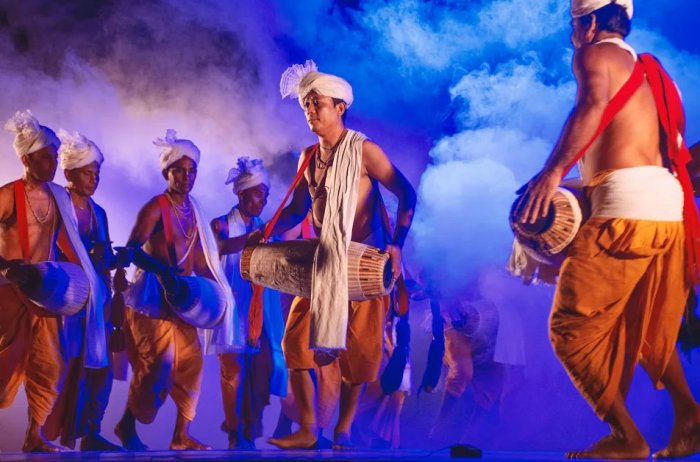 Pung group led by Brojen Singh Bimbavati, daughter of Guru Bipin Singh and Kalavati Devi, is what they call a chip off the old block. She has dance in her blood having learnt it from her mother from childhood and polished by her father. She has absorbed thoroughly the music and the movements. Graceful movements and complete involvement stand out in her dance and one can see that she is dancing with joy completely immersed into what she is performing. Her repertoire consisted of Guru Bipin Singh’s well known choreographic works like Krishna Rupa Varnana, describing the beauty of Krishna in typical style evolved by Guru Bipin Singh, using movements of ekapada bhramari, and graceful movements suggesting ornaments which adorn Krishna. The interesting solo was abhisarika nayika. The Natyashastra texts refer to sambhoga shringara and vipralambha shringara. The ashta nayikas are further divided with eight stages totaling 64. Guru Bipin Singh has explored the state of abhisarika nayika in futher eight states. She practices walking on the floor to overcome obstacles when she would venture in the night to go and meet Krishna. She sprinkles water on floor and walks on slippery floor balancing herself. She walks on thorns, tries to walk closing her eyes and opens them to see a serpent crossing her path, her sari getting entangled in thorn of a tree and so on. Bimba performed all this with consummate artistry, to the singing of “Vyakul Radhika,” Radhika in a state of frenzy moving anxiously to see Krishna. This year on 26th August on the closing ceremony of centenary celebrations in Kolkata, Bimbavati is to present this in a choreographic work titled ‘Ghana baari barikatha’ - meaning ‘reflection in a raindrop’. The original music is by Guru Bipin Singh, and Bimba has recomposed bols and interludes. N.Tiken Singh and Suman Sarkar have assisted in accompaniment whereas Priyarani Devi will sing and pung will be played by K.K.Upendra. ‘Saajat Tanum’ means incorporating animal gaits in Tanum, which is like Tarana of Hindustani music and Tillana of Carnatic music. It forms a part of Rasalila. Guruji has extracted it as a solo dance form and also as a group dance form for two to four dancers, inspired by the gaits of animals and birds that are seen in Kartal Cholom, Pung Cholom and Thang-ta. Some of the animal movements Bimba has used are from animal vahanas, vehicles of various gods and goddesses. She executed them with finesse. The finale Mahashakti described the power of Devi Jagaddhatri, the goddess with 10 weapons of war, the creator and the protector, the one who represents the ultimate Truth and Enlightenment. Bimba gets carried away and in a trance she emits cries to annihilate the demons. 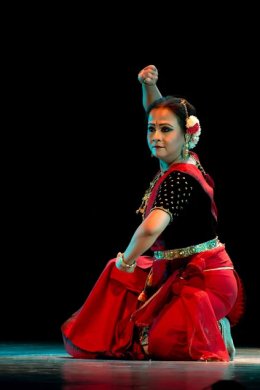 Bimbavati Devi 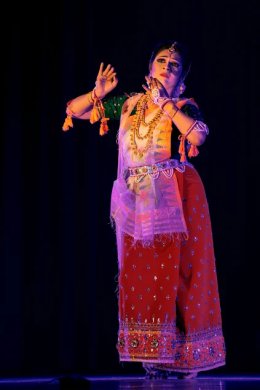 Samina Husain Prema Tamanna Rahman, the celebrated Manipuri dancer, was trained by Shantibala and later on she came to Kolkata and stayed with Guru Bipin Singh and further studied Manipuri, establishing her institution Nrityam Nrityasheelon Kendra. She could not present her solo as she was unwell. Her disciples presented dances on the second day. Samina Husain Prema is another young accomplished solo dancer, trained by Shantibala, Tamanna Rahman and at Chhayanaut Sangeet Vidyayatan of Sharmila Banerjee. She has further received training from Kalavati Devi. On academic side she has done her MA in Statistics from Dhaka University and has also obtained MA in Manipuri from Rabindra Bharati University. She presented solo Manini Radha. Guru Bipin Singh has conceived this basing it upon state of Radha, when at appointed time Krishna does not turn up and Radha waits for him for the whole night. As utkanthita nayika she had decorated her bed chamber, put on ornaments, prepared garlands. But when he arrives in the early morning carrying telltale marks of having spent time with other gopis, she is deeply hurt and as khandita nayika tells Krishna to go away. The well known ashtapadi “Yahi Madhava, Yahi Keshava” finds Radha as khandita nayika and she begs of Krishna to leave her. The padas of Vaishnava poets are used earlier and Gita Govinda ashtapadi is also used to suggest her distress. The vocal support was given by Kalavati Devi and pung was by Rajkumar Birmangal Singh. This was performed to recorded music. Samina has an attractive personality and she wore expressions in dignified manner. Sweety Das Chowdhury presented Kaliya Daman, dance choreographed by Guru Bipin Singh. The duel between Kaliya serpent and Krishna was enacted with vigour using tandava movements. 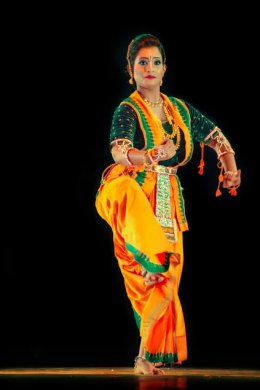 Sweety Das Chowdhury 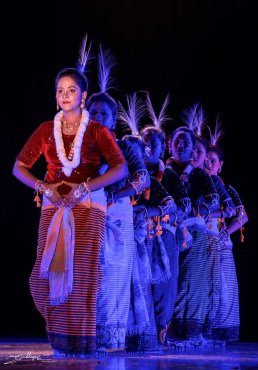 Nartan Malika choreographed by Sweety Das Photo: Asif Musaddeque Warda Rihab, a distinguished dancer trained by Sharmila Banerjee, Tamanna Rahman and Belayat Hossain Khan is currently studying under Kalavati and Bimbavati. Besides teaching at Chhayanaut Sangeet Vidyayatan, she also teaches at Indira Gandhi Cultural Centre and has her own institution Dhriti Nartanalaya. She obtained MA in Manipuri from Rabindra Bharati University. She performed Mridu Uddhat Krishna Nartan in which she used all the intricate and vigorous movements. With a commanding stage presence, she executed vigorous movements in tandava for Uddhata Nartana, and delicate movements for Mridu Nartana providing two contrasting aspects with distinct clarity. The number based on Tanchap of 4 beats and tala and another tala of 14 beats were executed with complete command. Warda is a name to reckon with among Manipuri exponents of Bangladesh. The next day, I was invited to speak on Guru Bipin Singh’s contribution to Manipuri dance. I am fortunate to have lived with Guru Bipin Singh, Kalavati and vocalist Atashi Chetterjee at their residence in Kolkata during my tenure as a Professor and Head, Dept of Dance, Rabindra Bharati University for ten years from 1980 onwards. Therefore, I had opportunity of seeing how Guruji taught, choreographed new solo dance numbers, trained Priti Patel and Sruti Banerjee, Tamanna Rahman and host of other Bengali dancers. I have written about Guruji’s contribution in emphasizing classical aspects on Manipuri dance which has now received universal approbation. What was indeed heartening was that Bangladeshi dancers had taken an initiative to celebrate his birth centenary, expressing gratitude for brining Manipuri dances to Bangladesh. And it has taken roots in a new 47 year old nation so widely. So many disciples of his having come to Kolkata and observing Gurukulavasa studied Manipuri dance and have established it as a major dance form. It speak volumes for Guru Bipin Singh’s contribution and the legacy he has left behind, which Kalavati and Bimba are carrying on by repeated regular visits conducting workshops. Guru Bipin Singh bani/style has got settled in Bangladesh. After my talk, dancers from Tamanna Rahman’s Nrityam Nrityasheelon Kendra presented Mangalacharan. Kamalika Das Tuli, Fatema Rahaman Farzin, Farhana Karim Tandra, Manomi Tanzana Orthy and others participated. From Shadanga Prabandha Nartana, comprising of 3 parts of shabda, birudu, pata, Guruji has created interesting elements; in first part Krishna’s beauty is described. In second part Swaramala composed of swaras, solfas sa, re, ga, ma, pa etc., in Surfak tala of 10 matras and third part consists of Telena in Chau tala of 12 matras. The composition stands out for its confluence of various elements which make the item rich. ‘Suka Sari Katahakata’ is based upon Guru Bipin Singh’s ‘Suka sari dwandwa’ composition. Tamanna has kept the spirit intact but used popular Bengali song with the same theme in which parrot praises Krishna as supreme Lord, where as she-parrot Sari, praises Radha as supreme goddess. Later on both agree that both Krishna and Radha are supreme but one. In Bajikar Khel, Krishna comes to Radha’s place in guise of acrobat with other cowherd boys to impress her about his skills in playing games. Guru Bipin Singh has employed various gaits, and acrobatic movements which delight Radha and her companions. It is performed with abandon by dancers dressed in colourful costumes and green pugrees with ornaments. It creates interesting visuals and also brings variety in dance. Manipuri dances consist of several varieties. To cull from them in an artistic manner suitable for urban centres, Guru Bipin Singh’s contribution has been well recognized. Of the various institutions teaching, Manipuri Bhabna is another noteworthy one established in 2007 by Samina Husain Prema. Besides, Manipuri Bhabna also offers training in folk, Martial Art and Contemporary dances. With guidance and help from Kalavati and Brojen Singh, Samina undertook to choreograph Krishnalila. In order to give opportunity to several young boys and girls, the theme revolved round Krishna playing with his cowherd boys. They beg of Yashoda to let him come and play with them. Krishna also pleads with mother Yashoda whose heart melts and she allows Krishna to go with them. They climb trees and pick up fruits and enjoy eating. Then arrives Bakasura sent by Kamsa, to kill Krishna. The demon opens his beak and swallows Krishna and cowherd boys, but Krishna breaks Bakasura’s beak and saves himself and his companions. They all dance with joy in unison. The finale of Krishnalila was shown in Holi kreeda and by Maharasa. Gopis play Holi with Krishna throwing coloured powder. In Manipuri Rasalila dancers use petals of flowers for coloured powder and not real 'abil' and 'gulal' coloured powder. Krishna brings syringe supposed to be filled with coloured water and aims them at Gopis, in particular at Radha. The Gopis protect her. Krishna then picks up syringes and throws them away and all dance with joy. When Gopis feel proud, Krishna disappears and they lament for their ego, praying to Krishna and surrender to him. Then Krishna takes several forms and dances between each Gopi to the rendering of ‘Anganam anganam antare Madhavo, ek Gopi ek Shyam.’ Dressed in traditional Manipuri costumes with mirrored skirts, covering their faces with gossamer veils, Gopis perform in circle around Krishna. Radha wears green mirrored skirt, whereas other Gopis wear red coloured mirrored skirts. Several dancers dressed as Krishna with attractive colourful crown and yellow silk pitambar, placing themselves between Gopis create most beautiful visual. The Gopis bring chowries and fan Krishna and Radha in the centre, bring lamp arati and offer flowers. The musician blows two conches and with Mangala shloka the Rasalila ends. Invariably this devotional performance makes one feel privileged to witness it. It is a sight for the gods. 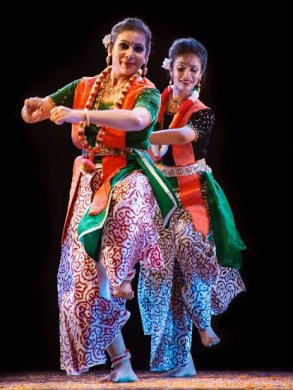 Warda Rihab & Tasmia Tabassum Protity The group dance by the Ghoramara artists led by Brojen Singh included dances of Lai Haraoba, Maiba and Maibis with placing their palms in shape of Yoni near their navel. They danced also Thabal Chouba, group dance performed by majority of dancers. The most interesting part was Basak when Preamila from Imphal sang in tara saptak in extreme high pitch praise of Gaurang, matched by equally high pitch singing by Usha, vocalist from Ghoramara, who sang for the first time in this group dance. The pung dancers executed various gaits of animals found in Kartal Cholom and Pung Cholom. What we had seen as rehearsal in the morning at Shadhona institute was transferred into a spectacular group performance offering a variety of drum dances. One drum dancer took aerial movements holding a large drum and played with incredible frenzy. The dancers carrying drums danced with colourful flag bearers as seen during Holipala, festival of Holi in Imphal, at Shri Shri Govindaji’s temple. It was also fascinating to watch two drummers engaging in a duet, like jugalbandi and playing on pung. The vitality of seven pung dancers arranging themselves in an ascending order with frontal view created engaging visual. Brojen Singh explored several possibilities of presenting male pung players and the artists from Ghoramara village stole the show with their dancing and singing and excellent pung playing. One was thrilled to see the traditional alive and throbbing with life. The two day dance festival (June 22 & 23) showcased the rich variety of Manipuri dance on part of Bangladeshi dancers. And one realized that neither caste nor creed mattered. The spirit of devotion permeated the performers and also the audience.  Dr. Sunil Kothari is a dance historian, scholar, author and critic, Padma Shri awardee and fellow, Sangeet Natak Akademi. Dance Critics' Association, New York, has honoured him with Lifetime Achievement award. Post your comments Please provide your name and email id when you use the Anonymous profile in the blog to post a comment. All appropriate comments posted with name & email id in the blog will also be featured in the site. |